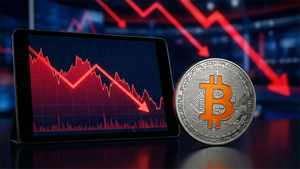
President Donald Trump's administration has aggressively pursued a pro-cryptocurrency agenda throughout 2025, culminating in a series of executive orders designed to cement the United States' position as a global leader in digital assets. While these moves have been met with widespread enthusiasm from the crypto community, a recent executive order, "Democratizing Access to Alternative Assets for 401(K) Investors," has ignited a fierce debate and drawn sharp warnings from prominent lawmakers. On October 28, 2025, Senators Elizabeth Warren (D-Mass.) and Bernie Sanders (I-Vt.), alongside five other Democratic senators, explicitly cautioned that President Trump's initiative could expose millions of Americans' retirement accounts to the volatile and often opaque world of cryptocurrencies and private equity, risking significant financial losses.
This pivotal moment in U.S. financial policy has seen the crypto market react with a mix of bullish fervor and cautious introspection. The administration's clear directives, from banning Central Bank Digital Currencies (CBDCs) to establishing a Strategic Bitcoin Reserve, have fueled optimism for innovation and growth. However, the direct push to integrate highly speculative assets into retirement savings has opened a new front in the battle between financial freedom and investor protection, posing profound questions about the future stability of individual retirement funds and the broader crypto ecosystem.
Market Impact and Price Action
President Trump's executive orders in 2025 have undeniably injected a powerful dose of bullish sentiment into the cryptocurrency market, reshaping investor expectations and driving significant price movements. The initial "Strengthening American Leadership in Digital Financial Technology" executive order on January 23, 2025, which revoked previous restrictive policies and prohibited CBDCs, was widely seen as a green light for innovation. This was followed by the landmark "Establishment of the Strategic Bitcoin Reserve and United States Digital Asset Stockpile" executive order in March 2025, which formalized Bitcoin's status as a strategic national asset.
Following these announcements, the market experienced a notable upswing. Bitcoin (BTC) saw its market value surge, reportedly climbing by 10% to over $94,000 after the March announcement, recovering from a three-month low below $80,000. Ethereum (ETH), which had faced significant losses earlier in the year, also experienced a substantial gain of 13%. Other cryptocurrencies mentioned for potential inclusion in the national stockpile, such as XRP, Solana (SOL), and Cardano (ADA), also registered significant price spikes, reflecting broad investor confidence in the administration's pro-crypto stance.
While specific real-time data on trading volume and liquidity for these exact dates is still being compiled, the dramatic price movements strongly indicate a surge in trading activity and increased investor interest, contributing to enhanced market liquidity. This positive market reaction contrasts sharply with the more cautious and uncertain responses seen after former President Joe Biden's Executive Order 14067 in March 2022, which called for a comprehensive study of digital assets but offered less immediate clarity. Similarly, the market's response diverges from the negative impacts often seen following U.S. Securities and Exchange Commission (SEC) enforcement actions, which typically trigger price declines and reduced liquidity for targeted assets.
The overall shift towards a more supportive and clear regulatory environment has also influenced the broader sentiment around integrating crypto into retirement accounts. The perceived legitimization of digital assets, coupled with the explicit ban on CBDCs, has encouraged traditional financial institutions to reconsider their apprehension about offering crypto investment options within 401(k)s and IRAs. This shift in sentiment laid the groundwork for the more direct "Democratizing Access to Alternative Assets for 401(K) Investors" executive order, which, despite the senators' warnings, aims to further open these avenues, potentially unlocking a massive new capital pool for the crypto market.
Community and Ecosystem Response
The crypto community and ecosystem have responded with a mix of overwhelming optimism and cautious apprehension to President Trump's executive orders, particularly the recent directive concerning retirement accounts. Social media platforms like Twitter (now X) and Reddit have buzzed with discussions, reflecting the diverse perspectives within the digital asset space.
The general sentiment among crypto enthusiasts and influencers has been overwhelmingly positive regarding the administration's broader pro-crypto stance. The January and March 2025 executive orders, which promoted U.S. leadership in blockchain, protected activities like self-custody and mining, and explicitly banned CBDCs, were celebrated as a decisive shift towards fostering innovation. Influencers widely lauded the moves as positioning the U.S. to become the "crypto capital of the world," with many anticipating accelerated mainstream adoption and increased institutional investment. The subsequent appointment of crypto-friendly commissioners at the SEC, with Hester Peirce reportedly leading a "Crypto 2.0" task force, further fueled this optimism for a clear and supportive regulatory future.
However, the "Democratizing Access to Alternative Assets for 401(K) Investors" executive order, signed around August 7, 2025, has generated a more nuanced and often critical response, particularly concerning its implications for retirement savings. While some proponents, like Swan Bitcoin CEO Cory Klippsten, have called the inclusion of Bitcoin in 401(k)s "inevitable," expecting growing allocations from younger, tech-savvy workers, many on Reddit forums (e.g., r/Bogleheads, r/Economics) expressed significant concerns. Users voiced fears about exposing "hard-earned savings" to highly volatile assets, the potential for "pump and dump" schemes, and conflicts of interest, especially given the Trump family's own ventures into crypto meme coins ($TRUMP, $MELANIA) and NFTs. There's a palpable divide between those advocating for more investment choice and those prioritizing robust investor protection, particularly for less financially sophisticated individuals.
Beyond retirement accounts, the broader crypto ecosystem has generally viewed the regulatory clarity and supportive environment as beneficial. DeFi protocols anticipate a more streamlined path for innovation and growth, with the administration showing less inclination towards stringent tax reporting requirements that could hinder decentralized finance. The NFT market has also seen a direct impact, notably with the continued success and renewed interest in "Trump Digital Trading Cards," demonstrating the intersection of political engagement and digital collectibles, albeit with ongoing legal claims of pump-and-dump activities shadowing some related projects. Web3 applications, in general, are expected to thrive under a framework that supports technological advancement and market growth, particularly those integrating AI into decentralized applications.
The concerns raised by Senators Elizabeth Warren and Bernie Sanders on October 28, 2025, specifically target the 401(k) order. They, along with five other Democratic senators, sent a letter to Labor Secretary Lori Chavez-DeRemer and SEC Chairman Paul Atkins, warning that the executive order could "harm millions" by exposing retirement savings to risky crypto and private equity investments. They emphasized the lack of transparency, higher price swings, and insufficient oversight compared to traditional assets, echoing public interest groups like Better Markets, which have urged states to prohibit crypto investments in public pension funds due to volatility and fraud risks. This senatorial pushback highlights the ongoing legislative efforts to either solidify or restrict cryptocurrency investments in retirement accounts, setting the stage for continued political and regulatory battles.
What's Next for Crypto
The crypto market now stands at a pivotal juncture, navigating the ambitious directives of President Trump's administration and the increasing scrutiny from legislative bodies. In the short term, the market is likely to continue riding the wave of optimism generated by the pro-crypto executive orders. The clear regulatory signals, coupled with the explicit ban on CBDCs and the establishment of a Strategic Bitcoin Reserve, are expected to maintain a bullish sentiment, potentially attracting further institutional and retail capital. The newly formed President's Working Group on Digital Asset Markets and the SEC's "Crypto 2.0" task force are poised to roll out more detailed regulatory frameworks, which, if supportive, could reduce immediate uncertainties and boost confidence.
However, the immediate future for crypto's integration into retirement accounts remains a battleground. While the "Democratizing Access to Alternative Assets for 401(K) Investors" executive order aims to open 401(k)s to crypto, the strong warnings from Senators Warren and Sanders, coupled with fiduciary concerns from employers, could significantly slow actual adoption. Many financial advisors predict that employers will proceed with extreme caution, potentially taking months or even years for these options to become widespread due to liability risks under the Employee Retirement Income Security Act (ERISA). This means that while the option for crypto in 401(k)s exists, its practical implementation might be a gradual process, dependent on evolving legal interpretations and employer comfort levels.
In the long term, President Trump's policies could fundamentally reshape the U.S. and global digital asset landscape. The sustained push for regulatory clarity, combined with a supportive administration, has the potential to firmly establish the U.S. as the leading hub for blockchain innovation and cryptocurrency businesses. This could lead to a significant influx of talent, capital, and pioneering projects into the U.S. crypto sector. The Strategic Bitcoin Reserve, in particular, could lend long-term legitimacy to Bitcoin as a reserve asset, potentially influencing other nations to consider similar strategies and initiating a "race of nations" to accumulate digital assets. Furthermore, with a clear preference for USD-backed stablecoins and a ban on CBDCs, regulated stablecoins are likely to see their role cemented as a key component of the digital financial system.
Potential Catalysts and Strategic Considerations:
- Catalysts to Watch: The full implementation of the proposed federal regulatory frameworks, significant employer adoption of 401(k) crypto options, further legislative action (like the CLARITY Act or GENIUS Act) to codify executive mandates, and global regulatory harmonization efforts will all be crucial catalysts.
- For Projects and Businesses: Prioritizing regulatory compliance, focusing on real-world utility and robust security, developing products that cater to institutional and retail on-ramps, and actively advocating for responsible innovation will be paramount.
- For Investors: Due diligence, risk management, a long-term investment horizon, and diversification are essential. Consulting financial professionals who understand both traditional retirement planning and digital assets is highly advisable, especially for those considering crypto in their 401(k)s.
Possible Scenarios:
- "Crypto Capital" Achieved (Base Case): The U.S. successfully implements a supportive framework, leading to significant capital inflows, sustained market growth, and broader adoption, solidifying its global leadership.
- Regulatory Backlash and Slow Adoption: Strong political opposition and employer liability concerns significantly slow the integration of crypto into 401(k)s, leading to a more gradual adoption process for retirement funds, even as other crypto sectors benefit from clearer regulations.
- Unintended Consequences and Market Instability: Rapid deregulation combined with increased accessibility in retirement funds leads to periods of heightened volatility and significant investor losses, triggering renewed calls for stricter regulation.
- Global Crypto Reserve Race: The U.S. Strategic Bitcoin Reserve spurs other major economies to actively pursue their own national crypto reserves, further legitimizing Bitcoin on a global scale.
Bottom Line
President Trump's 2025 executive orders have ushered in an unprecedented era for cryptocurrency in the United States, signaling a definitive shift towards fostering innovation, establishing regulatory clarity, and even integrating digital assets into national reserves and, controversially, retirement accounts. For crypto investors and enthusiasts, the key takeaway is the administration's strong commitment to positioning the U.S. as a global leader in the digital asset space, which has generally been met with bullish market reactions. However, the "Democratizing Access to Alternative Assets for 401(K) Investors" order introduces a new layer of complexity and risk, particularly for individual retirement savers.
While the long-term significance of these policies could be transformative for crypto adoption, potentially unlocking trillions in retirement capital, it comes with a significant caveat: the inherent volatility and speculative nature of cryptocurrencies. Senators Warren and Sanders' warnings underscore the critical need for extreme caution and robust risk management when considering crypto for retirement portfolios. The debate highlights the tension between providing investment freedom and protecting everyday Americans from potentially devastating losses.
Ultimately, what this means for crypto adoption is a dual path: a likely acceleration of institutional and technological integration driven by supportive regulation, alongside a more cautious and potentially slower rollout for direct retail exposure within traditional retirement vehicles. Important dates and metrics to monitor include the progress of the President's Working Group on Digital Asset Markets, further guidance from the Department of Labor and the SEC on 401(k) offerings, legislative efforts in Congress to either codify or restrict these executive orders, and crucially, the actual uptake rate of crypto options by employers for their retirement plans. The market will also closely watch Bitcoin's price movements, trading volumes, and overall market capitalization as indicators of sustained confidence in the new regulatory landscape.
This article is for informational purposes only and does not constitute financial or investment advice. Cryptocurrency investments carry significant risk.




